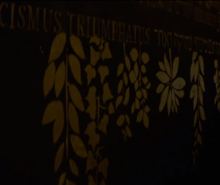Saducismus Triumphatus

Saducismus triumphatus[1] is a book on witchcraft by Joseph Glanvill, published posthumously in England in 1681.
The editor is presumed to have been Henry More, who certainly contributed to the volume;[2] and topical material on witchcraft in Sweden was supplied by Anthony Horneck to later editions. By 1683 this appeared as a lengthy appendix.[3] Horneck's contribution came from a Dutch pamphlet of 1670.[4][5] Its composition is mentioned in the chapter on Transportation by an invisible power in the Miscellanies of John Aubrey.[6]
The book affirmed the existence of
Influence

The book strongly influenced Cotton Mather in his Discourse on Witchcraft (1689) and the Salem witch trials held in 1692–3 in Salem, Massachusetts. Mather's Wonders of the Invisible World (1693) is largely modeled after this book and its reports, particularly the material relating to the Mora witch trial of 1669.[4] The book is cited by H. P. Lovecraft in his short story "The Festival". Shirley Jackson quoted passages from the book in her short story collection The Lottery and Other Stories.[7]
In popular culture
It is possible to read the title painted on the walls of the secret passage in Dario Argento's 1977 film Suspiria at 01:29:19.

The book is mentioned in H.P. Lovecraft's short story "The Festival":
"Pointing to a chair, table, and pile of books, the old man now left the room; and when I sat down to read I saw that the books were hoary and mouldy, and that they included old Morryster’s wild Marvells of Science, the terrible Saducismus Triumphatus of Joseph Glanvill, published in 1681, the shocking Daemonolatreia of Remigius, printed in 1595 at Lyons, and worst of all, the unmentionable Necronomicon of the mad Arab Abdul Alhazred, in Olaus Wormius’ forbidden Latin translation; a book which I had never seen, but of which I had heard monstrous things whispered."
See also
Notes
- ^ Saducismus triumphatus: or, Full and plain evidence concerning witches and apparitions. In two parts. The first treating of their possibility. The second of their real existence.
- ^ . Dictionary of National Biography. London: Smith, Elder & Co. 1885–1900.
- ^ . Dictionary of National Biography. London: Smith, Elder & Co. 1885–1900.
- ^ a b Ankarloo, Bengt and Henningsen, Gustav (editors) Early Modern European Witchcraft: Centres and Peripheries (1990). Oxford: Oxford University Press. p. 431-3.
- High Dutch, however, i.e. in German.
- ^ John Aubrey (1784). Miscellanies Upon Various Subjects. University of Michigan. Printed for W. Ottridge.
- ISBN 0-374-52953-1.
External links
- Concerning Witches and Apparitions, a modernised version of Saducismus Triumphatus was published in July 2023 by Holythorn Press, ISBN 978183845331
- Graphical reproduction of Sadducismus Triumphatus at the University of Pennsylvania library.
- Sadducismus Triumphatus at the Internet Archive.
